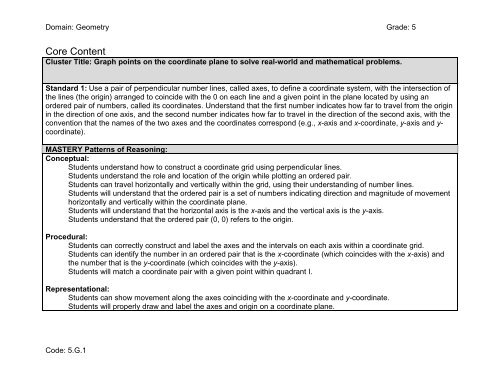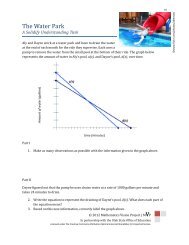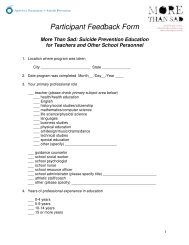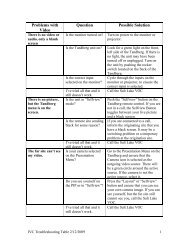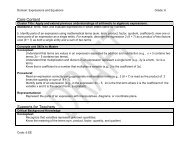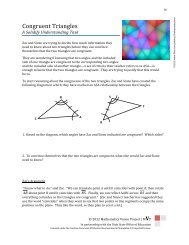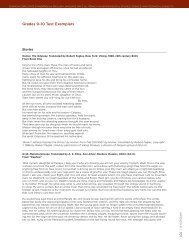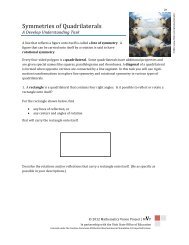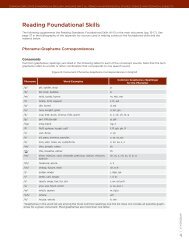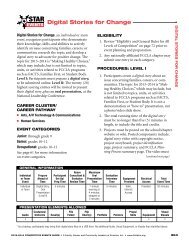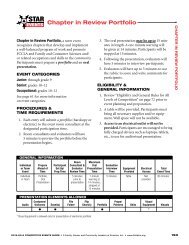Graph points on the coordinate plane to solve real-world and ...
Graph points on the coordinate plane to solve real-world and ...
Graph points on the coordinate plane to solve real-world and ...
Create successful ePaper yourself
Turn your PDF publications into a flip-book with our unique Google optimized e-Paper software.
Domain: Geometry Grade: 5<br />
Core C<strong>on</strong>tent<br />
Cluster Title: <str<strong>on</strong>g>Graph</str<strong>on</strong>g> <str<strong>on</strong>g>points</str<strong>on</strong>g> <strong>on</strong> <strong>the</strong> <strong>coordinate</strong> <strong>plane</strong> <strong>to</strong> <strong>solve</strong> <strong>real</strong>-<strong>world</strong> <strong>and</strong> ma<strong>the</strong>matical problems.<br />
St<strong>and</strong>ard 1: Use a pair of perpendicular number lines, called axes, <strong>to</strong> define a <strong>coordinate</strong> system, with <strong>the</strong> intersecti<strong>on</strong> of<br />
<strong>the</strong> lines (<strong>the</strong> origin) arranged <strong>to</strong> coincide with <strong>the</strong> 0 <strong>on</strong> each line <strong>and</strong> a given point in <strong>the</strong> <strong>plane</strong> located by using an<br />
ordered pair of numbers, called its <strong>coordinate</strong>s. Underst<strong>and</strong> that <strong>the</strong> first number indicates how far <strong>to</strong> travel from <strong>the</strong> origin<br />
in <strong>the</strong> directi<strong>on</strong> of <strong>on</strong>e axis, <strong>and</strong> <strong>the</strong> sec<strong>on</strong>d number indicates how far <strong>to</strong> travel in <strong>the</strong> directi<strong>on</strong> of <strong>the</strong> sec<strong>on</strong>d axis, with <strong>the</strong><br />
c<strong>on</strong>venti<strong>on</strong> that <strong>the</strong> names of <strong>the</strong> two axes <strong>and</strong> <strong>the</strong> <strong>coordinate</strong>s corresp<strong>on</strong>d (e.g., x-axis <strong>and</strong> x-<strong>coordinate</strong>, y-axis <strong>and</strong> y-<br />
<strong>coordinate</strong>).<br />
MASTERY Patterns of Reas<strong>on</strong>ing:<br />
C<strong>on</strong>ceptual:<br />
Students underst<strong>and</strong> how <strong>to</strong> c<strong>on</strong>struct a <strong>coordinate</strong> grid using perpendicular lines.<br />
Students underst<strong>and</strong> <strong>the</strong> role <strong>and</strong> locati<strong>on</strong> of <strong>the</strong> origin while plotting an ordered pair.<br />
Students can travel horiz<strong>on</strong>tally <strong>and</strong> vertically within <strong>the</strong> grid, using <strong>the</strong>ir underst<strong>and</strong>ing of number lines.<br />
Students will underst<strong>and</strong> that <strong>the</strong> ordered pair is a set of numbers indicating directi<strong>on</strong> <strong>and</strong> magnitude of movement<br />
horiz<strong>on</strong>tally <strong>and</strong> vertically within <strong>the</strong> <strong>coordinate</strong> <strong>plane</strong>.<br />
Students will underst<strong>and</strong> that <strong>the</strong> horiz<strong>on</strong>tal axis is <strong>the</strong> x-axis <strong>and</strong> <strong>the</strong> vertical axis is <strong>the</strong> y-axis.<br />
Students underst<strong>and</strong> that <strong>the</strong> ordered pair (0, 0) refers <strong>to</strong> <strong>the</strong> origin.<br />
Procedural:<br />
Students can correctly c<strong>on</strong>struct <strong>and</strong> label <strong>the</strong> axes <strong>and</strong> <strong>the</strong> intervals <strong>on</strong> each axis within a <strong>coordinate</strong> grid.<br />
Students can identify <strong>the</strong> number in an ordered pair that is <strong>the</strong> x-<strong>coordinate</strong> (which coincides with <strong>the</strong> x-axis) <strong>and</strong><br />
<strong>the</strong> number that is <strong>the</strong> y-<strong>coordinate</strong> (which coincides with <strong>the</strong> y-axis).<br />
Students will match a <strong>coordinate</strong> pair with a given point within quadrant I.<br />
Representati<strong>on</strong>al:<br />
Students can show movement al<strong>on</strong>g <strong>the</strong> axes coinciding with <strong>the</strong> x-<strong>coordinate</strong> <strong>and</strong> y-<strong>coordinate</strong>.<br />
Students will properly draw <strong>and</strong> label <strong>the</strong> axes <strong>and</strong> origin <strong>on</strong> a <strong>coordinate</strong> <strong>plane</strong>.<br />
Code: 5.G.1
Domain: Geometry Grade: 5<br />
Supports for Teachers<br />
Critical Background Knowledge<br />
C<strong>on</strong>ceptual:<br />
Students have an underst<strong>and</strong>ing of perpendicular lines.<br />
Students underst<strong>and</strong> <strong>the</strong> terms “vertical,” “horiz<strong>on</strong>tal,” <strong>and</strong> “intersect.”<br />
Students know how <strong>to</strong> move al<strong>on</strong>g a number line (including varied intervals).<br />
Students can explain how <strong>to</strong> move al<strong>on</strong>g paths in <strong>real</strong>-<strong>world</strong> situati<strong>on</strong>s involving distance. For example, which is<br />
far<strong>the</strong>r from <strong>the</strong> school—<strong>the</strong> grocery s<strong>to</strong>re or <strong>the</strong> post office—<strong>and</strong> in what directi<strong>on</strong> would you have <strong>to</strong> travel <strong>to</strong> get<br />
<strong>to</strong> <strong>the</strong>re.<br />
Students underst<strong>and</strong> that you begin at zero when working with a number line.<br />
Students can explain how a number line works, even if it is displayed vertically.<br />
Procedural:<br />
Students will be able <strong>to</strong> locate <str<strong>on</strong>g>points</str<strong>on</strong>g> <strong>on</strong> a number line despite its orientati<strong>on</strong>.<br />
Students can create number lines with differing intervals.<br />
Representati<strong>on</strong>al:<br />
Students can represent vertical <strong>and</strong> horiz<strong>on</strong>tal lines.<br />
Students can represent intersecting perpendicular lines.<br />
Students can create number lines.<br />
Academic Vocabulary <strong>and</strong> Notati<strong>on</strong><br />
perpendicular, right angle, intersect, vertical, horiz<strong>on</strong>tal, <strong>coordinate</strong>s, x-axis, y-axis, <strong>coordinate</strong> <strong>plane</strong>/grid, origin, x-<br />
<strong>coordinate</strong>, y-<strong>coordinate</strong>, ordered pair, intervals<br />
Instructi<strong>on</strong>al Strategies Used<br />
Create a life-size grid in <strong>the</strong> classroom <strong>on</strong> <strong>the</strong> floor using<br />
yarn <strong>to</strong> make <strong>the</strong> perpendicular axes. Label <strong>the</strong> axes. Have<br />
students physically move al<strong>on</strong>g <strong>the</strong> grid, exploring<br />
movements al<strong>on</strong>g <strong>the</strong> x-axis <strong>and</strong> <strong>the</strong> y-axis, <strong>the</strong>n discuss<br />
how that movement can be represented with ordered pairs.<br />
Use multimedia <strong>to</strong> explore grids <strong>and</strong> <strong>the</strong> use of ordered pairs<br />
(see resources for “Ordered Pairs”).<br />
Code: 5.G.1<br />
Resources Used<br />
Ordered Pairs<br />
http://www.learnalberta.ca/c<strong>on</strong>tent/me5l/html/math5.html<br />
Fly <strong>on</strong> <strong>the</strong> Ceiling, by Dr. Julie Glass<br />
ISBN: 0-679-88607-9
Domain: Geometry Grade: 5<br />
Assessment Tasks Used<br />
Skill-Based Task:<br />
On a <strong>coordinate</strong> grid, have students identify a specific point<br />
(e.g., What are <strong>the</strong> <strong>coordinate</strong>s of <strong>the</strong> point where <strong>the</strong> rabbit<br />
is located?).<br />
Give students ordered pairs that <strong>the</strong>y must match <strong>to</strong> <str<strong>on</strong>g>points</str<strong>on</strong>g><br />
<strong>on</strong> <strong>the</strong> <strong>plane</strong> within <strong>the</strong> first quadrant.<br />
Problem Task:<br />
Give students a map of <strong>the</strong> school <strong>on</strong> a <strong>coordinate</strong> grid<br />
<strong>and</strong> ask <strong>the</strong>m <strong>to</strong> identify where certain places in <strong>the</strong> school<br />
are found. Then have students tell what is located at a<br />
particular given <strong>coordinate</strong> pair.<br />
Students label <strong>the</strong> origin, x- <strong>and</strong> y-axes, <strong>and</strong> correct intervals<br />
<strong>on</strong> graph paper with a set of perpendicular lines <strong>and</strong> a set of<br />
<str<strong>on</strong>g>points</str<strong>on</strong>g> already drawn. Have student match <strong>the</strong> previously<br />
drawn <str<strong>on</strong>g>points</str<strong>on</strong>g> <strong>to</strong> <strong>the</strong> correct ordered pair from a list of given<br />
<strong>coordinate</strong> pairs.<br />
Code: 5.G.1


